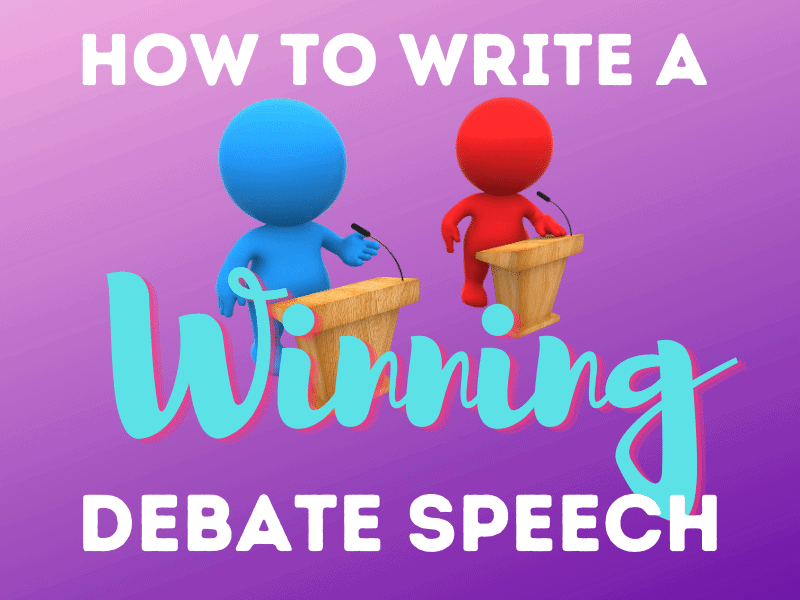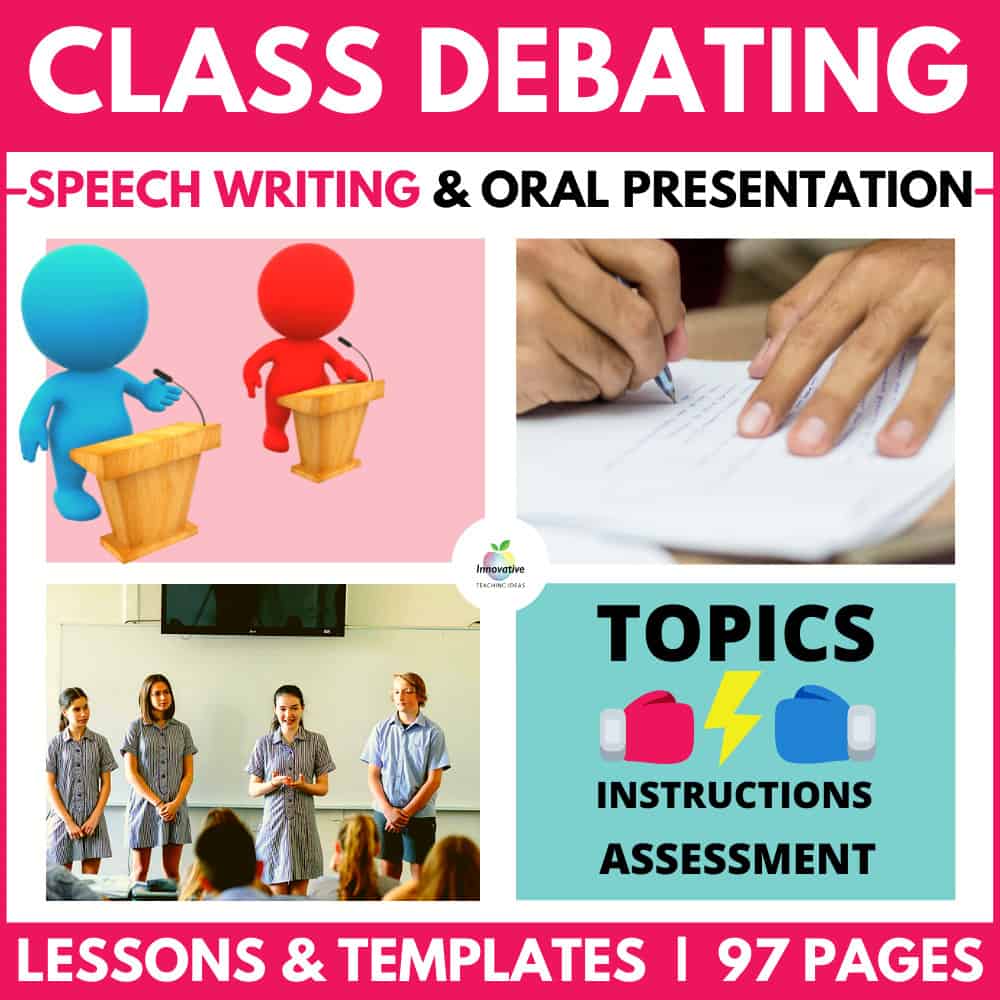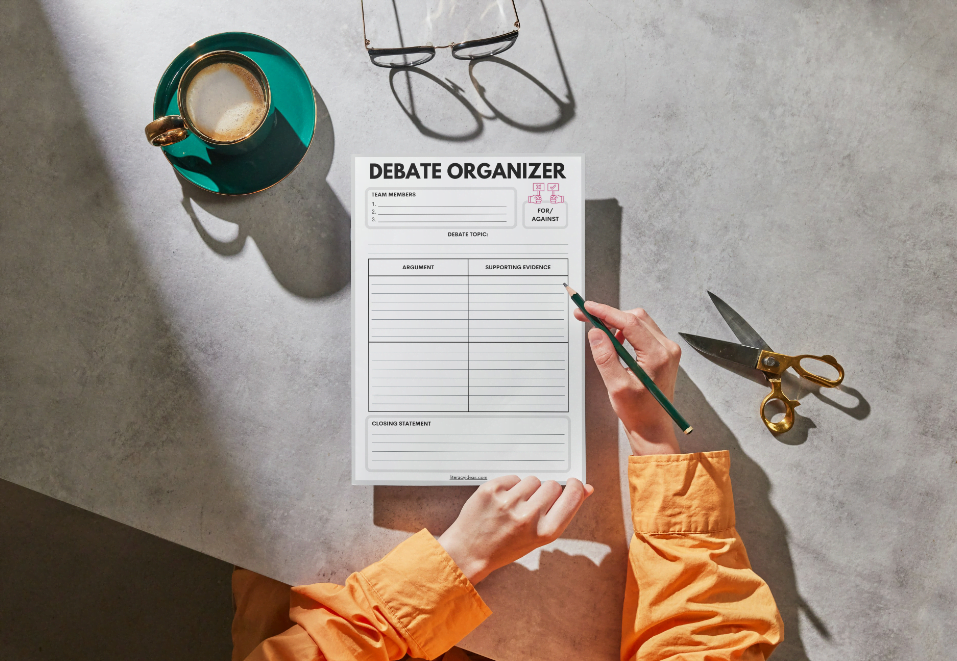

A classroom debate involves students delivering persuasive speeches to present and support their opinions on a given subject. This activity helps develop critical thinking and communication skills, enabling students to gain a more comprehensive grasp of various topics.
Debate speeches are written according to a set of rules so a moderator can assess their effectiveness and allow others to question or challenge their statements within a formal debate.
A classroom debate is not an unruly fight or pointless argument but a structured formal conversation on a chosen topic in which two teams argue for or against it to convince the neutral moderator that they hold the stronger position.
Debating is a form of persuasive communication, and while we will be sticking to the fundamentals of how to write a debating speech, we also have a great guide to persuasive essay writing that elaborates on specific persuasive techniques.

This unit will guide your students to write excellent DEBATE SPEECHES and craft well-researched, constructed ARGUMENTS ready for critique from their classmates.
Furthermore, this EDITABLE UNIT will provide the TOOLS and STRATEGIES for running highly engaging CLASSROOM DEBATES.

Stay fousssed with this handy template to keep all your ideas organized.
In highly competitive speech and debate tournaments, students are only provided the topic on the day, and limited time is allowed for preparation, but this is not recommended for beginners.
Regardless of the stakes of your classroom debate, the speechwriting process always begins with research. Thorough research will provide students with both the arguments and the supporting evidence for their position on a topic and generate forward-thinking about what their opponents might use against them.
The purpose of the introduction in a debate speech is to achieve several things:
Securing the audience’s attention is crucial, and failure to do this will have a strong, negative impact on how the team’s efforts will be scored as a whole. Let’s explore three proven strategies to hook your audience and align their thinking to yours.
| Hook Type | Details |
|---|---|
| Use a Quotation From a Well-Known Person | Quotes from reputable individuals add credibility and authority to your arguments. They demonstrate that influential figures endorse your viewpoint. They provide a concise and impactful way to convey complex ideas or express a widely accepted perspective. Quotations can resonate with the audience, evoke emotions, and make your speech more memorable. By referencing respected individuals, you tap into their expertise and reputation, supporting your position and increasing the persuasive impact of your debate speech. Using a quotation from a well-known person is a great way to draw eyeballs and ears in the speaker’s direction. People love celebrities, even if that celebrity is relatively minor. Using a quotation to open a speech lends authority to what is being said. In addition, the quotation chosen will usually be worded concisely and interestingly, making it all the more memorable and impactful for the audience. |
| Use Statistics and Data to Support Your Position | Quotes from reputable individuals add credibility and authority to your arguments. They demonstrate that influential figures endorse your viewpoint. They provide a concise and impactful way to convey complex ideas or express a widely accepted perspective. Quotations can resonate with the audience, evoke emotions, and make your speech more memorable. By referencing respected individuals, you tap into their expertise and reputation, lending support to your position and increasing the persuasive impact of your debate speech. Using a quotation from a well-known person is a great way to draw eyeballs and ears in the speaker’s direction. People love celebrities, even if that celebrity is relatively minor. Using a quotation to open a speech lends authority to what is being said. In addition, the quotation chosen will usually be worded concisely and interestingly, making it all the more memorable and impactful for the audience. |
| Use a Personal Anecdote To Warm Up The Audience | An anecdote is a short, personal story that illustrates or emphasizes a point, often used to make a subject more relatable, and they are a valuable way to ease the audience into a complex topic. Your stories can be used to make complicated moral or ethical dilemmas more relatable for an audience. Anecdotes are also an effective way for the speaker to build a rapport with the audience, which, in turn, makes the task of persuading them an easier one. |
Once the audience’s attention has been firmly grasped, it’s time to introduce the topic or the motion. This should be done straightforwardly and transparently to ensure the audience understands the topic of the debate and the position you are approaching it from.
For example, if the topic of the debate was school uniforms, the topic may be introduced with:
“Today, we will debate whether school uniforms should be compulsory for all high school students.”
A thesis statement is a concise declaration summarizing the points and arguments of your debating speech.
The thesis statement should express the student’s or the team’s position on the motion. Clearly explaining the speaker’s side of the debate. An example can be seen here.
“Today, we will debate whether school uniforms should be compulsory for all high school students. This house believes (or, I believe…) that school uniforms should not be compulsory for high school students.”
The final part of the introduction section of a debate speech involves previewing the main points of the speech for the audience.
There is no need to go into detail with each argument here; that’s what the body of the speech is for. It is enough to provide a general thesis statement for each argument or ‘claims’ – (more on this to follow).
Previewing the arguments in a speech is especially important as the audience and judges only get one listen to a speech – unlike a text, which can be reread as frequently as the reader likes.
"Ladies and gentlemen, esteemed judges, and fellow students, imagine a world where access to education is not a privilege but a fundamental right. Today, I stand before you to affirm that education should be free for all. It is time we break down the barriers that limit opportunities and build a society where knowledge is not determined by one's financial circumstances." "Good morning, respected panel of judges and fellow classmates. The topic at hand demands our attention and action: should genetically modified organisms (GMOs) be embraced or rejected? As I step forward, I firmly believe that GMOs hold the potential to revolutionize agriculture, alleviate world hunger, and shape a sustainable future. Let us delve into the complexities of this issue and explore why embracing GMOs is a crucial step towards a better world." "Honorable adjudicators, distinguished guests, and fellow debaters, today we confront the controversial question of whether social media is a blessing or a curse. In an era defined by virtual connections, viral trends, and endless scrolling, it is imperative to recognize the tremendous impact social media wields. As I take the affirmative stance, I assert that social media, when used responsibly, empowers individuals, amplifies voices, and paves the way for positive societal change. Join me in this exploration of the transformative power of our digital age."